#sims4rococo
Explore tagged Tumblr posts
Text
slightly anachronistic walk through 18th century Versailles. The main anachronism is : the set shown grand bedchamber and the council cabinet are winter sets(1881 and 3318) while the one in the new bedchamber, the green one(the 4000) is a summer set, the proper set in that room one should have been winter set 2691, but since the colour scheme of gold and crimson of that set is also in way already represented in the previous rooms I thought that the saxon green of summer 4000 could add a bit more variety.
Besides those details the rest is fairly accurate, except perhaps some of the fireplace clocks which are still place holders.
All the cc shown in the clip is still WIP.
#sims4cc#sims4rococo#ts4 historical#versailles#history#sims 4 custom content#sims4#palace of versailles#historical research#ts4cc
86 notes
·
View notes
Text
THE SIMS 4 - ROCOCO DRESS V3
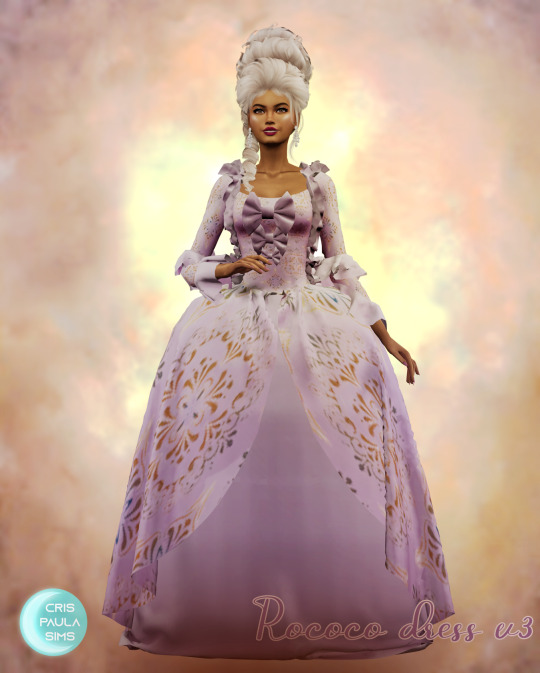
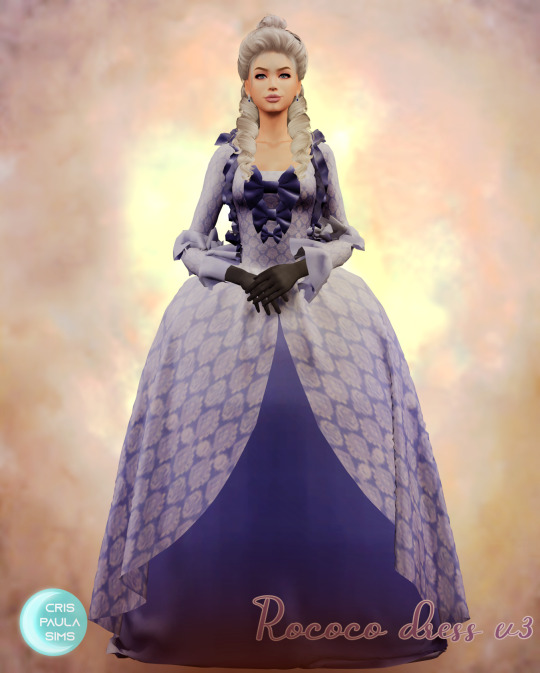
Nova malha
Compatível com jogo base
Por favor, Não reivindique como seu
Problemas com o meu conteúdo? Me Avise!
DOWNLOAD (blog, direct mediafire)
#thesims4#sims4cc#sims4dress#sims4#sims4rococo#thesims4cas#cassims4#the sims 4 download#the sims 4 content#thesims4clothing#the sims cc#the sims custom content#the sims download
30 notes
·
View notes
Photo
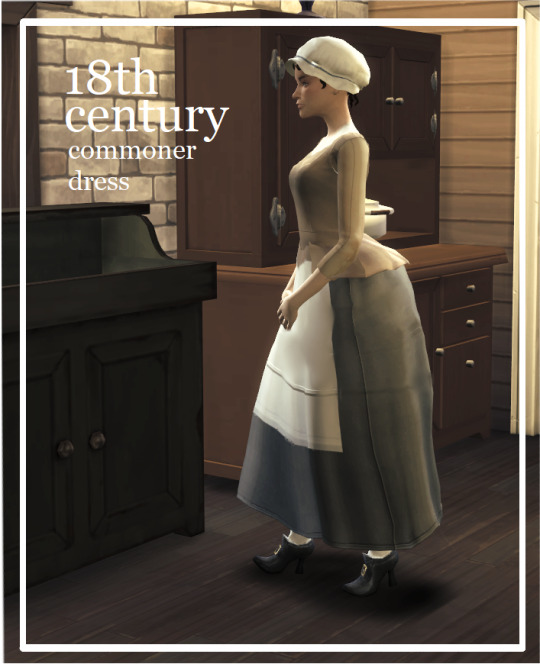
18th century commoner’s dress (excuse the typo in the pic)
bgc, 10 swatches
here it is! again, i posted it earlier but wasn’t happy with the result so here it is again.
https://simfileshare.net/folder/98920/
#CC#sims4history#sims 4 history challenge#the sims 4 history challenge#ts4ccmm#ts4mmcc#s4cc#ts4cc#wcif friendly#sims4marieantoinette#sims4rococo#sims418thcentury#thesims4history
492 notes
·
View notes
Text
The Choiseul Box Part 1
It is available for free here

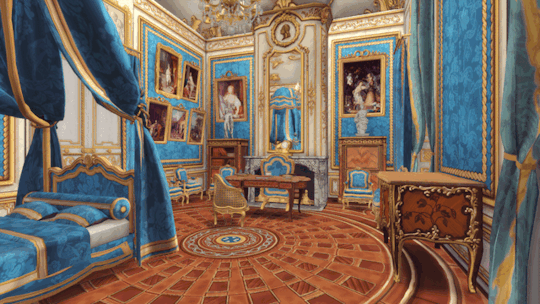
The set was already public for over a month now, however this time I decided to make the cane chair base game compatible, fix some shadow aberration on the cabinet, correct the colour of the blue swatch of the chair and added a second version of chair.
#sims4cc#sims 4 custom content#ts4cc#sims4rococo#ts4 historical#ts4ccfurniture#the sims 4#sims 4#sims custom content#ts4 custom content
426 notes
·
View notes
Text
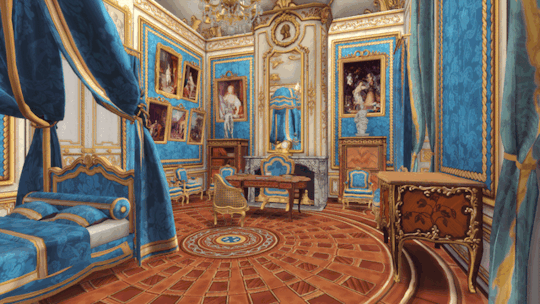
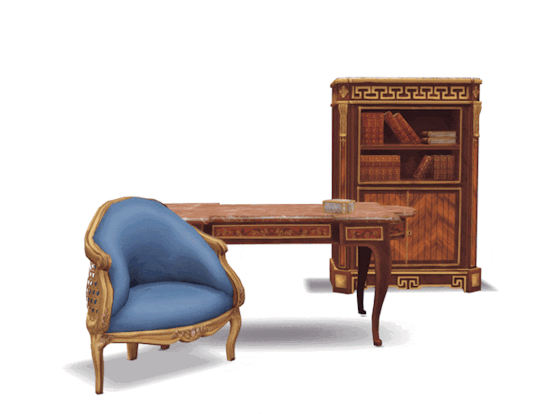
The Choiseul Box, Part 1 The Blue Bedchamber
The Choiseul box set part 1, is based on the blue bedchamber, from the hotel Crozat rue de Richelieu in Paris, that late Louis XV prime minister the duke of Choiseul inhabited during the 1760s. The set is available on early access here
The public release is set from the 3rd of July(in 36 days), however people who DM after a month could get it earlier in their DM. I also did remove the paywalls from the Queen bedchamber and the Queen antechamber that were still in place.
The Queen bedchamber will be partly updated in the future along side the King bedchamber and the updated versions will be publicly available from the beginning. But unlike the King's bedchamber, the Queen's bedchamber update will not cover the whole set, but will be limited to certain pieces which aren't fully accurate, namely certain fabrics and beds(with 5 beds instead of 2) and 1 extra sofa. This decision to update them comes from the fact that I manage to put my hand on various work reports from the national archives giving very detailed descriptions of each of the sculpted "couronnements" ornating the top some of bed canopies that were in that room(namely the one from 1743, the one from 1764, the one from 1769 and the one from 1770)
If you encounter any issues with ones of the items from the set please inform me so I can fix then as soon as possible.
#the sims 4#sims4cc#ts4ccfurniture#ts4cc#versailles#sims custom content#sims 4#sims4 palace#sims 4 maxis match#the sims community#ts4#the sims#the sims cc#ts4 custom content#sims4rococo#ts4ccfinds#ts4 cc#ts4 cc mm
551 notes
·
View notes
Text
THE BOULLE MARQUETRY SET IS OUT!
*enable the sound on the video for some Lully*
You can Download it here
Public release on the 15th of November

Includes 6 Boulle marquetry cabinets or desk based on those made by André-Charles Boulle or Nicolas Sageot between 1690 and 1710. Each of the items features 5 swatches based on exiting historical variations.
The Louis XIV bust featured in the video as well as the other busts are by @thejim07
The folding stools aren't included in this set but will be in my next one.
Important : you will have to follow this tutorial to get decent quality textures on any of my sets.
#sims4cc#sims4rococo#ts4cc#ts4 historical#the sims 4#ts4ccfurniture#sims 4#sims custom content#ts4 custom content#versailles#louis xiv#sims 4 cc#sims 4 custom content#sims 4 build#ts4 build
383 notes
·
View notes
Text
Close up of the pattern of brocade 135(June 1698)

three of the items from set 1870 delivered in May 1700, the upholstery used -as explained in the part II C of my study on the bedchamber- can be traced to a delivery from the 12th of June 1698, under the number 135 described as ”brocade from Lyon with silver background, flowers patterns of gold and silver surrounded by thin contours of red, green and purple silk”


The top image of the brocade discharge for set 1870(AN O1/3307 f⁰ 420 r⁰) and the second one is the first entry of brocade 135(AN O1/3307 f⁰ 360 r⁰) used for the upholstery of the 1870
#history#palace of versailles#historical research#sims4cc#sims4rococo#sims 4 custom content#sims4#ts4cc
37 notes
·
View notes
Text
Part VI: The 1702 Summer Set(N⁰ 1379) :

Tradition required the bedchamber decor to be changed twice a year, alternating between a winter set and a summer one. Although set 1881 is not explicitly referred to as the winter set in the Garde-Meuble until 1740 [125], André Félibien informs us that the practice of using red velvet for winter in the King’s bedchamber predated 1701 [126]. If set 1881 was already used for winter by 1701, then which set was used as a summer replacement in 1702? The answer can be found in the 1708 inventory [127], where a set of silver-background brocade is listed under number 1379. Set 1379 was initially delivered in May 1689 as an augmentation of set 867, delivered nine years earlier for the bath apartments [128].
6.1 The Tapestry Itself
Described in 1680 as alternating narrow pieces of two different brocades—one “silver background with figures of a shepherd and shepherdess” and the other “gold and silver with rinceau, outlined at the edge with ponceau” [129]—the 1689 Garde-Meuble entry, while consistent in describing the shepherd silver brocade, specifies that the other had a green background but omits the rinceau ornaments. The most complete description appears in the 1708 inventory: “Rich furniture of two brocades, one with silver background with figures of shepherd and shepherdess in gold and silver, and the other with green background chiseled with gold and with flowers of silver and gold” [130].
The 1689 delivery was intended to fill an alcove with eight pieces of silver shepherd brocade and seven pieces of the green brocade [131]; this layout remained the same in the 1701 bedchamber [132].
6.2 The Bed
The main element of set 1379 was its state bed, impressive in its dimensions. Its components were as follows:
No Headboard: None of the descriptions indicate the presence of a headboard.
The Headcloth: Described in 1689 as being like the curtains, “of ponceau brocade” [133]. As seen in Part 6.1, no ponceau brocade is mentioned in the set; instead, the color ponceau only appears as a border for the green-background brocade. This discrepancy is later clarified in 1708 when the curtains and headcloth are accurately described as “green background brocade with flowers of gold and silver outlined at the edge with ponceau” [134].
The Valences: Unlike previous descriptions, a more precise one does not come from the 1708 inventory, where they are mentioned along with the cantonières, bonne grace, and bases as simply being of “shepherd brocade” [135], but from the May 1689 Garde-Meuble entry, which states: “Three outer valences, with additional buttonholes, shells, tassels, and other embroidery taken from the campane left from the frieze of the tapestry; four inner valences. The seven valences [three outer + four inner] are entirely of the shepherd brocade, garnished at the bottom by large campane embroidery and at the top and sides by smaller campanes, with ponceau gros de tours lining” [136].
The Curtains: The fabric for the curtains matched the set: some were of shepherd brocade, while others were of the green brocade.The 1689 description specifies that the two bonne graces, two cantonières, and three bases were of the shepherd brocade, while the four outer-layer curtains were of the “ponceau brocade” [137]. As with the headcloth, the term "ponceau brocade" actually refers to the “green background brocade with flowers of gold and silver outlined at the edge with ponceau,” as inferred from the 1708 inventory [138].
The Quilt: Described in both 1689 and 1708 as being of “ponceau brocade” [139], the same caution regarding interpretation should be applied as above.
The Case Curtain: Made of 24 pieces of green taffeta sewn together, with large and medium gold and silver fringes at the bottom and sides [140].
The Columns: The two front columns were covered in sheaths: one in a brocade featuring Solomonic columns embroidered in gold and silver on a crimson satin background, and the other in a brocade with silver stripes and satin stripes adorned with gold and silver floral embroidery [141].
The Vases/Finials: Four in total (one at each corner), filled with feathers. No further information about the materials used is provided.
6.3 The Armchairs and Stools

The original 1680 description briefly mentions the presence of two armchairs [142].
In 1689, the armchairs and stools received new frames, which were “gilded and silver-plated.” The 12 stools from 1680 were replaced with eight folding stools at that time [143].
The armchairs were entirely covered with shepherd brocade on the backrest, seat, and armrests, with silver and gold braid and campane ornaments. The folding stools, on the other hand, had cushions made from a square of shepherd brocade surrounded by “ponceau brocade.” This term appears in both the 1689 Garde-Meuble entry [144] and the 1708 inventory [145]. We learn from the 1689 entry that there was not enough campane to decorate all eight folding stools; there was barely enough for six, and the remaining two had to rely on gold fringes instead [146]. This issue seems never to have been addressed, as the 1708 description notes this disparity as well [147].
These stools and armchairs were later encountered long after being removed from the bedchamber and returned to the Garde-Meuble, specifically in the 1775 general inventory of the Garde-Meuble, where they appear under number 106 among the brocade furnishings [148]. In this final description, we learn that, just as in 1708, the disparity in campane ornaments remained unaddressed and that the “ponceau brocade” mentioned in the 1689 and 1708 descriptions surrounding the shepherd brocade was, as expected, actually “of chiseled green background brocade, with silver and gold flowers” [149].
An additional armchair belonging to set 1870 is also listed in the 1708 inventory.
6.4 The Fire Screen

The fire screen was a new addition for the 1701 central bedchamber, as it was not part of the original delivery of set 1379 from May 1689. The 1708 inventory offers a lengthy description worth quoting in full:
“Fire screen with slide [écran à coulisse], covered on each side with a square of silver background brocade with vine, from which a grape hangs, with a shepherdess at the center enclosed by strips of green background brocade chiseled with gold, with gold and silver floral ornaments outlined at the edge with ponceau, garnished by a thin gold braid hiding the seam, with sculpted and gilded wood” [150].
6.6 The Table and Tablecloth
In 1689, at the initial delivery of the set, there were three different carpets (tapis), one of which was referred to as a table carpet (tapis de table) [151]. Although no table was provided with the initial delivery, the 1708 inventory mentions a fir wood table [152] with no inventory number listed directly after two of the aforementioned rugs, indicating that these other rugs were also likely table rugs, as was the first.
The first proper tablecloth was “made of the two brocades, garnished with fringes and gold and silver braids, lined with green taffeta” [153].
The second rug was made of green leather, with green taffeta lining and gold fringes.
The third rug, made of green taffeta with gold and silver fringes, is referred to in 1708 as the slipcover for the first.
6.7 The Portieres
The description of the four portieres is consistent between the 1689 Garde-Meuble entry and the 1708 description, comprising a total of five pieces of brocade sewn together: three of shepherd brocade and two of the green brocade, with campane ornaments at the bottom of two and fringes for the other two.
[125] AN O1/3453
[126] “The King’s bed is covered in red velvet in winter,” can be read in Félibien des Avaux, Description sommaire de Versailles ancienne et nouvelle, 1703 edition, p. 60. Despite the date of the edition, the rooms are described in their pre-1701 layout.
[127] AN O1/3445 f⁰ 2-4
[128] Guiffrey, Inventaire général du mobilier de la couronne sous Louis XIV, 1886 edition, vol. 2, p. 318
[129] Ibid
[130] AN O1/3445
[131] AN O1/3306 f⁰ 123 r⁰
[132] AN O1/3445
[133] AN O1/3306 f⁰ 122 r⁰
[134] AN O1/3445 f⁰ 2 • [135] Ibid
[136] AN O1/3306 f⁰ 122 r⁰
[137] Ibid
[138] AN O1/3445 f⁰ 3
[139] See previous footnotes
[140] AN O1/3445 f⁰ 2
[141] AN O1/3306 f⁰ 123 v⁰
[142] Guiffrey, 1886, vol 2, p.318
[143] AN O1/3306 f⁰ 122 r⁰
[144] Ibid v⁰
[145] AN O1/3445 f⁰ 3
[146] AN O1/3306 f⁰ 122 v⁰
[147] AN O1/3445 f⁰ 4
[148] AN O1/3345, f⁰ 272 v⁰
[149] AN O1/3445 f⁰ 3
[150] Ibid
[151] AN O1/3306 f⁰ 123 r⁰
[152] AN O1/3445 f⁰
[153] Ibid, AN O1/3306 f⁰ 123 r⁰
#sims4cc#sims 4 custom content#sims4rococo#sims4#ts4cc#ts4 historical#versailles#history#palace of versailles#historical research
35 notes
·
View notes
Text
Part VIII: Louis XV’s Summer Set (N⁰ 2200)

When Louis XV returned to Versailles in 1722 and took possession of his great-grandfather's royal apartments, the Garde-Meuble had to provide a new summer set for the bedchamber cabinet since the previous one had left the palace after the Sun King’s death. Lallie was charged with the task, and on the 8th of May, 1723, he delivered a new set of furniture covered in a purple and crimson background brocade which received the number 2200. The set was created using several brocades from Lyon delivered by Gautier in 1688. The set remained in the bedchamber for the rest of Louis XV’s reign and most of the reign of his successor, who restored it in 1776 [161].
8.1.1 The Tapestry Itself
Described in 1723 as being made of a “brocade from Lyon with purple and crimson background, with compartments, cornucopia, and large flowers woven in silver and gold, with crimson silk used around as contour [nuee de soye cramoisy]” [162], it is said that brocade numbers 48 and 49 were used for that set. The description of these brocades from the 1729 general inventory provides additional details [163]: the compartments are referred to as “large compartments,” and there is mention of rinceaux ornaments woven in gold, which was not noted in 1723. The description also specifies the roles of the purple and crimson: purple was the main background color of the brocade, while crimson was used as the background color within the compartment and as a contour around the woven ornaments. This description allows us to trace the brocade’s origin. Indeed, on the 7th of October, 1688, the Garde-Meuble diary records the entry of a new brocade delivered by Gautier under the numbers 123 [164], 132, 133, and 134, with a description matching that of number 48 from the 1729 general inventory.
In the alcove, five pieces of this brocade were placed alongside six pieces of column brocade similar to those described in Part 7.1, which, by that time, had been renumbered as 52 in the 1729 general inventory [165].
8.1.2 The Bed

As before, the set featured a large state bed containing:
The Headboard: Described as enriched with gold leaf ornaments and gold braid [166].
The Valences: Three outer and four inner valences, described as being “enriched with woven gold leaf ornaments, forming festoons” [167]. The comma in between could suggest that the festoon shape describes only the valences, not the woven details. However, since most valences of the time had woven decorations that followed the valences' shapes, it would be safe to assume that this description applies to both. While no fringes are explicitly mentioned alongside the valences, the presence of woven gold crepines at their bottom may suggest their presence, especially since the bed bases, similar in description, included fringes. Furthermore, the work report by L’Heritier during the 1776 restoration explicitly charged for gold fringes for the valences of the summer bed [168], giving the valences an appearance close to those described in Part 6.2.

The Curtains: Two bonnes grâces, four curtains, and two cantonières made of the purple and crimson brocade with gold braid and fringes, lined with a crimson satin woven with gold and featuring multiple compartments [169].
The Quilt: Made of the same brocade, adorned with gold braids and fringes.
The Case Curtain: Made of crimson gros de Tours, with large and medium-sized gold fringes at the bottom and edges, hanging from a golden rod [170].
The Columns: The four columns were sheathed in crimson satin with gold and silver woven decorations [171].
The Vases/Finials: Four in total (one at each corner), filled with 120 feathers, covered in brocade with added gold leaf patterns and braids [172].
8.1.3 The Armchairs and Stools

Two armchairs and twelve stools were listed for this set. The brocade used for their upholstery differed from that of the bed and the alcove, described as “another narrow brocade with a crimson background, featuring cornucopia and fleurets with gold and silver, with a contour of purple silk to match the bed’s brocade” [173]. This detail reinforces the idea that the bed’s main brocade color was indeed purple. This brocade likely corresponds with brocade number 36 from the 1729 general inventory [174], which is said to have been used for this set at the end of the entry [175]. This brocade came from a delivery in 1686 by the Parisian manufacturer Charlier, initially assigned the number 93 [176].
One detail stands out when comparing descriptions: the contour around the silver and gold decorations is said to have been purple silk when used on the stools and armchairs in 1723, whereas it was originally green silk in 1686. It is likely that this alteration was made by Lallie or one of his suppliers to better match the purple color of the other brocade.
The woods are noted as having been gilded and sculpted “very richly.” This detail is interesting as it may reflect a stylistic shift occurring at that time, with more richly decorated armchairs that, unlike their Louis XIV counterparts, featured backrests framed by a visible, elaborately sculpted wooden border.
The entry also references gold fringes and braids.
8.1.4 The Fire Screen

The screen was covered in the same purple and crimson brocade as used for the bed and the alcove. The wood was sculpted and gilded, and the central motif of the brocade was surrounded by a gold braid [177].
8.1.5 The Table and Tablecloth

The table was made of walnut and described as having a lower cabinet shape (table en bas d’armoire) with a counter on each side, closing with a key. While convertible cabinets were common in the 18th century, this specific design with only a lower part and counters on each side was very unusual. It measured 42 inches long, 29 inches wide, and 31 inches tall [178].
This table is mentioned in the 1751 Versailles inventory as a “lower walnut cabinet opening from both sides” [179] and was present in the winter decor alongside set number 1881 (discussed in Part 4). Although it was omitted from the summer set, we can infer its presence by the mention of the tablecloth and the practice of mentioning items present in both summer and winter only once [180]. Later Versailles inventories omit the table but continue to list the tablecloth used alongside it.
The tablecloth had four bases—three of the purple brocade and the fourth of taffeta—all embellished with gold braids and fringes and lined with taffeta.
8.1.7 The Portiere Tapestries
Set 2200 featured, like the previous sets, four portiere tapestries in front of each of the four doors. Each was made using three pieces of the purple brocade, with gold fringes at the side and bottom, and lined with crimson taffeta [181].
[161] AN O1/3625
[162] AN O1/3309 f⁰ 351 v⁰
[163] AN O1/3338 f⁰ 275 r⁰
[164] AN O1/3306 f⁰ 108 v⁰
[165] AN O1/3338 f⁰ 276 r⁰
[166] AN O1/3309 f⁰ 351 v⁰
[167] AN O1/3309 f⁰ 351 v⁰
[168] AN O1/3625, L’Heritier’s work report
[169] AN O1/3309 f⁰ 351 v⁰
[170] Ibid f⁰ 352 r⁰
[171] Ibid
[172] Ibid
[173] AN O1/3309 f⁰ 352 r⁰
[174] AN O1/3346 f⁰ 273 r⁰
[175] AN O1/3309 f⁰ 354 r⁰
[176] AN O1/3306 f⁰ 14 v⁰
[177] AN O1/3309 f⁰ 352 v⁰
[178] Ibid
[179] AN O1/3454 p. 2
[180] See previous notes
[181] AN O1/3309 f⁰ 352 v⁰
#sims4cc#sims 4 custom content#sims4#sims4rococo#ts4cc#ts4 historical#versailles#history#palace of versailles#historical research
35 notes
·
View notes
Text
Part VII Louis XIV’s Final Summer Set (N⁰ 1984)

The fate of this set is, like its entry, somewhat perplexing as contemporary sources contradict one another. Memorialists of the time claim that instead of inheriting the set, the Duke of Tresmes, First Gentleman of the Room, received financial compensation [162], while the Garde-Meuble, on the other hand, maintains that the Duke did in fact inherit the set alongside those present in the Antechamber and Cabinet [163]. The latter version is the most plausible, as it explains both the absence of set 1984 from the 1729 general inventory and the decision to create a new summer set for the bedchamber upon Louis XV’s return to Versailles in 1723.
Furthermore, the death inventory of the Duke of Tresmes in 1739 mentions a satin Persian-style crimson background, present on the second floor of his townhouse under the number 135 [164], corresponding to the set described in the death inventory of King Louis XIV, which was meant to be inherited by the Duke.

page from the Duke of Tresmes Death Inventory, Number 135 AN MC ET II 473
7.1 The Tapestry Itself
The brocades used in the creation of set 1984 came from earlier deliveries in 1687 and 1688 by the Parisian fabric supplier Charlier. Indeed, at the end of the 1705 entry, we learn that Lallié used brocades numbered 96, 991, 116, and 128 for the bed, seats, footrest cushions, tablecloth, and fire screen, described as “a satin Persian-style brocade,” also referred to as the small-pattern brocade. Brocades 95 and 98, called the large-pattern brocade, were used for the bed and alcove tapestry. These brocades were described on July 23, 1686, as “pieces of brocade one ell wide, with crimson background with patterns of gold and silver in Persian colors” [165]. The delivery of brocade 98 can be traced to February 4, 1687 [166]. Jules Guiffrey reconstructed a more complete description of the brocade by combining elements mentioned in several sources: “Five pieces of rich brocade, one ell wide, with crimson red satin background; featuring compartments, cornucopias, scrolls, and flowers woven in gold and silver, with contours around the ornaments in violet, green, and blue silk, in the Persian style, made by Mr. Charlier of Paris” [167]. For the 1705 delivery, eight pieces of large brocade were destined for the alcove tapestry alongside seven pieces of column brocade. These column brocades were part of a delivery from November 29, 1688, by Gautier and manufactured in Lyon. They were described as “columns of rich brocade with vine branches and grapes, with a base and capital woven in gold and silver, twisted, with musk, on a crimson satin background” [168] and received the number 124. Designs featuring twisted brocade columns were fashionable at the time; Swedish diplomat Cronström even discussed similar ones in his correspondence with Swedish royal architect Tessin, where they considered possible decor for royal apartments in Sweden. Cronström wrote, “One could also take satins from Turin and have twisted columns and borders or friezes made, cut according to the design of Mr. Berain. All of this would be appropriate, new, and in good taste.” Mr. Berain was indeed the royal ornamentalist for the King of France. The column designs Cronström referenced, which he sketched, are now in the Stockholm National Museum collection.

National Museum, Stockholm, NMH CC 1382 recto
This layout, however, differs from the one described in the King’s bedchamber at King Louis XIV’s death, where set 1984 is mentioned with an alcove tapestry of only five pieces of large brocade alongside six pieces of column brocade [169]. Moreover, the dimensions of the alcove tapestry as described in 1705 far exceed the size of the bedchamber’s western wall, given that each large piece of brocade was one French ell wide (1.18m) and the brocade column half that width, totaling 13.6 meters (44.52 ft). This discrepancy suggests set 1984 was used in the Versailles King’s bedchamber almost incidentally rather than as a planned choice. This discrepancy in the alcove layout of 1715 featured only five pieces of the large brocade, each one ell wide, and six pieces of column brocade, each half an ell wide, totaling eight French ells or 9.44 meters (31 ft), which is much closer to the actual dimension of the King’s alcove.
7.2 The Bed
The main element of set 1984 was its state bed, with its impressive dimensions. Its components were:
• No Headboard: None of the descriptions indicate the presence of a headboard.
• The Headcloth: Made of two pieces of the large brocade according to the 1705 Garde-Meuble diary [170] and four according to the 1715 death inventory [171].
• The Valences: Both the 1705 and 1715 entries spare details on the main fabric used, only noting crimson satin lining. It could be inferred that they were crimson to match the background of the brocade. Large gold fringes formed festoons at the bottom [172], and this style of valence, different from the previously used campanes, was increasingly popular at the time. Similar ones appear in a painting by Louis Silvestre depicting Louis XIV Receiving the Prince Elector of Saxony in his Fontainebleau bedchamber near the end of his life.

: Louis XIV reçoit à Fontainebleau le prince-électeur de Saxe, 27 septembre 1714, Louis de Silvestre and Hyacinthe Rigaud, oil on canvas, 1715, 120 x 155 cm, Château de Versailles, MV 4344
• The Curtains: Two bonnes grâces, four curtains, and two cantonières are mentioned, with gold fringes at the edges and bottom, lined with the same fabric. The brocade used is not specified, but we can infer that it was the smaller pattern given that the headcloth, mentioned afterward, is said to have been of “the larger pattern brocade,” implying the curtains were not.
• The Quilt: See above.
• The Case Curtain: Made of crimson gros de Tours taffeta, with gold fringes at the bottom and edges, hanging from a golden rod.
• The Columns: The two front columns were placed in a sheath of large-pattern brocade.
• The Vases/Finials: Four in total (one at each corner), filled with feathers and covered in the large-pattern brocade.
7.3 The Armchairs and Stools

Two armchairs were included in the 1705 delivery [173] and three in 1715 [174]. We can assume that an additional armchair was added once the set was transferred to the bedchamber, possibly used with the table. They were garnished with gold fringes at the bottom, and their wood was surprisingly painted red with gold floral decorations. The brocade used was the small pattern, specifically brocades 96, 99, 116, and 128 as described on July 23, 1686: “Two pieces of brocade, two feet wide, with crimson background and elevated patterns in gold and silver with Persian colors” [175]. In 1886, Jules Guiffrey attempted to enhance that vague description by referencing entries from the brocade chapter of the 1729 general inventory and brocade discharges from set 1984, creating this more precise description of the small pattern brocade of number 96: “Two pieces of brocade, two feet wide, with crimson satin background, cornucopias, rinceaux, and flowers of elevated gold and silver, with outlines in green and purple silk, in the Persian style, from the Charlier manufacture in Paris” [176]. The specifics of the colors are consistent with brocade discharges noted at the end of the entry for set 1984 [177].
The twelve folding stools were similar in terms of brocade and style to the armchairs, with gold fringes and woods painted in red with some gilded ornaments.
6.4 The Fire Screen

The fire screen was similar to the seats, with the small-pattern brocade, gold braids around the edges, and wood painted to match the fabric. A braid with a lead pear covered with gold bouquets is also mentioned [178].
7.5 The Table and Tablecloth
The set came with a tablecloth made of the smaller brocade, with fringes on the sides and at the bottom, lined with taffeta, along with a red leather table rug with gold fringes. The table mentioned in the 1715 death inventory under these tablecloths was likely the fir table previously listed in the 1708 inventory and used with set 1379 (see Part 6.6) [179].
7.6 The Portières Tapestries
At the time of the 1705 delivery, no portières were included, and they only appear in the 1715 death inventory [180]. They were made from five pieces of brocade each and described as “assorted to the one of the bed.” Each of the four doors was equipped with one, embellished with gold fringes on their sides, and lined with crimson taffeta.
6.7 The Portieres Tapestries
At the time of the 1705 delivery, no portieres were included; they are only mentioned in the 1715 death inventory [160]. Made from five pieces of brocade each and “assorted to the one on the bed,” each of the four doors was equipped with one. They were embellished with gold fringes on their sides and lined with crimson taffeta.
[135] AN O1/3308 f⁰ 9 r⁰
[136] AN O1/3298 folder 3, item 4, f⁰ 1
[137] Verlet 1961 and Castelluccio 2016 mention set 1379 while omitting set 1984, while Meyer 1980 and Richard 2018 mention set 1984 while omitting set 1379.
[138] Hans 2022 confuses sets 1379 and 1984 and provides a description combining elements from both sets.
[139] AN O1/3308 f⁰ 9 r⁰
[140] Ibid f⁰ 134
[141] AN O1/3298 folder 3, item 4, f⁰ 2 v⁰
[142] The folio 135 of the 1705 Garde-Meuble diary (AN O1/3308) is missing.
[143] Saint-Simon, tome XXIII, p. 213; Dangeau Journal, éd. E. Soulié, Paris, Firmin Didot, 1854-1860, tome XVII, p. 177
[144] AN O1/3298 folder 3, item 2
[145] AN MC/ET/II 473
[146] AN O1/3306 f⁰ 31 v⁰
[147] Ibid f⁰ 59 v⁰
[148] Guiffrey, Jules. Inventaire général du mobilier de la couronne sous Louis XIV (1663-1715), deuxième partie. Paris: Au siège de la société, 1886, p. 198
[149] Ibid f⁰ 111 r⁰
[150] AN O1/3298
[151] AN O1/3308 f⁰ 7 v⁰
[152] AN O1/3298
[153] AN O1/3308 f⁰ 7 v⁰
[154] AN O1/3308 f⁰ 7 v⁰
[155] AN O1/3298
[156] AN O1/3306 f⁰ 31 v⁰
[157] Guiffrey, Inventaire général du mobilier de la couronne sous Louis XIV, 1886 edition, vol. 2, p. 198
[158] AN O1/3308 f⁰ 8 r⁰
[159] Ibid
[160] Ibid
#sims4cc#sims 4 custom content#sims4rococo#sims4#ts4cc#ts4 historical#versailles#history#palace of versailles#historical research
25 notes
·
View notes
Text
Part V the 1701 Winter Set(N⁰ 1881) :

The first entry of a new set of furniture for the brand-new bedchamber dates to November 1701, with the delivery by Lallié of a set made of richly embroidered crimson velvet. This set included three armchairs, twelve folding stools, two cushions used as footrests, a table covered by a cloth, and one fireplace screen, intended for use as winter decor [67]. It was assigned number 1881, which allows us to trace this set across time. Indeed, number 1881 reappears in the 1751 [68] inventory, then in the 1765 inventory [69], the 1776 [70] inventory, and finally in the 1785 inventory [71], before being mentioned one last time in 1785 on the occasion of its destruction [72], after 84 years of use. Despite its new inventory number, it was actually an update of an older velvet set, number 1504, originally delivered in April 1692 and mostly crafted at Saint-Cyr, as explained at the beginning of the November 1701 Garde-Meuble entry [73]. In later parts of the description, it is noted that the enhancement of the original embroidery took place at St. Joseph and was done by Mr. Cheury, probably following Lallié's instructions. In 1765, the set was further embellished, with Capin restoring the velvet [74] and Foliot adding a newly sculpted canopy top to the bed (see Part IX). This restoration resulted in several work reports that provide additional insights into the set.
4.1 The Velvet and Tapestry
As previously mentioned, the velvet used was based on an earlier delivery from 1692, which entered the Garde-Meuble in April 1692 under number 1504 and was described as:
“Grand set of crimson red velvet embroidered with a strong gold embroidery” [75].
While the rest of the entry mentions a canopy bed, two armchairs, twelve folding stools, and two footrest cushions, no reference to an alcove tapestry appears.
Interestingly, when Lallié delivered the updated version of the velvet in November 1701 for the King’s Bedchamber under number 1881, there was still no mention of an alcove tapestry [76]. Later, in September 1705, a new tapestry for the King’s bedchamber entered the Garde-Meuble under number 1989 [77].

The tapestry was said to have been made by Lebegne and consisted of two parts, each made up of eight pieces. This alcove tapestry would become the definitive one for the winter set, as tapestry 1989 and set 1881 are found together in various inventories from both the reigns of Louis XV and Louis XVI [78].
While the 1751 inventory is extremely vague, mentioning only “two pieces of crimson velvet tapestries” [79], the 1765 and 1785 inventories (which contain identical descriptions) provide a bit more detail: “two pieces of crimson velvet tapestries, 12 ft 4 in high, garnished at the top and bottom with gold fringes, with red canvas lining” [80].
One thing to emphasize about the alcove tapestry is its relative simplicity compared to the rest of the set. While set 1881 is described as a “rich velvet […] embroidered with gold,” no mention of gold embroidery appears in descriptions of alcove tapestry 1989. This lack of embroidery may have been balanced by the presence of the two alcove paintings that accompanied the winter decor. Furthermore, the tapestry is later listed under the velvet chapter of the 1752 inventory [81], while the richly embroidered furniture of set 1881 appears in the embroidery chapter [82].
4.2 The Bed

The main element of set 1881 was its state bed, with impressive dimensions (7 ft 4 in wide, 7 ft 8 in long, and 12 ft 3 in tall), a symbol of the monarch even more so than the throne itself. Its components were as follows:
The Headboard: Described as “very rich” without further detail. The later parts of the 1701 Garde-Meuble entry specify that, unlike many pieces in the set, it was entirely made from scratch and did not incorporate elements from set 1504 [83]. Two contemporary depictions of the bed with its headboard exist, allowing a better visualization of the piece, while depictions of the king’s bed from other residences can also provide a more complete picture.More details on the headboard appear in various reports from the 1765 restoration, though some alterations might have occurred at that time, potentially differing from its original 1701 state.Capin described the headboard in his 1765 work report as having the same type of embroidery as the headcloth, adorned with tinsel [clinquant]. He later specifies that “[the headboard is] adjusted in its wooden frame lined with cloth, garnished by its platband, assembled and tightly held in place [dressé avec grande sujession]” [84].Chasblier, who worked on the embroidery in 1765, described his work on the headboard as follows: “The headboard […] reembroidered, with tinsels and flourish [cliquant et fioritures], outlined [liseré] with gold lace” [85].The headboard does not appear in Bardon’s report, who restored the gilding of the set in 1765, possibly indicating that, even at that time, the headboard’s wooden frame was entirely covered by gold-embroidered cloth, with no gilding applied directly to the wood [86].
The Headcloth: The 1701 description merely acknowledges its presence [87], likely reusing the one from set 1504 [88]. In both instances, the Garde-Meuble entries contain no further details on the headcloth's ornamentation. However, the depiction of the bedchamber shown in fig. 19 includes a headcloth with large embroidery in its center.Capin’s 1765 report describes it as being made of crimson velvet (like the rest of the set) with embroidery matching that found on the headboard [89].Chasblier’s report aligns with Capin’s observation: “9 ft tall headcloth, entirely disassembled and reembroidered, with tinsels and flourish [cliquant et fioritures], outlined [liseré] with gold lace, and placed on a brand-new velvet cloth” [90].
The Valences: Their 1692 description goes no further than mentioning three outer valences and four inner ones, but the 1701 Garde-Meuble entry provides more detail, referring to them as “campanes” [91]. They were lined with taffeta, gold moire, and outlined with crimson red chenilles. This style of valence is consistent with the iconography of royal beds during the later years of the Sun King’s reign. The end of the 1701 entry clarifies their origin: they were brand new and not reused from the 1692 set [92]. It should be noted that campane-style ornaments became increasingly popular at that time and were not limited to canopy valences (see fig. 37).Descriptions of the valences from the 1765 reports are less relevant for discussing the room’s state during Louis XIV’s reign. As Chasblier explained, the new embroidery was entirely remade to match the newly added sculpted canopy [93].
The Bases: Described in 1701 as similar to the valences, with campane ornaments [94].
The Curtains: The 1701 entry mentions four curtains, two bonne graces, and four cantonières. Besides acknowledging their presence, the Garde-Meuble provides no specific details about their appearance. However, it does provide a few details about the lining of the bonne graces and cantonières, which were “red and gold brocade with fleur-de-lys” [95]. The same fabric was used around the bed columns, with the brocade in question being part of brocades 118, 130, and 101, which entered the Garde-Meuble in the late 1680s [96].
The Quilt: While previous descriptions are vague about the motifs in the velvet’s ornamentation, the quilt may offer more insight into the entire set. The 1701 entry specifies that it was “garnished […] with a braid of gold bouquets [bouquetterie], just like the one around the canopy [de meme qu’au tour de l’Imperial]” [97].Capin and Chasblier’s descriptions are consistent with previous reports, mentioning “tinsels and flourish,” though the report by the L’Heritier brothers, suppliers of silk and embroidery, adds additional key insights.

“26th September, following the order from the 8th to regarnish the square of the quilt from the King’s winter bed in the palace of Versailles.
9 aune 4 of gold braid from Paris, richly embroidered and garnished with sequins […] very rich, two inches wide […]
6 aune 4 of gold braid from Paris, two inches wide […]
16 pointy florets of Spain from Paris, with tinsel made of cloth to garnish two valances […]
17 aune of gold embroidery from Paris featuring festoons […]” [98].
These details add a more floral dimension to the previously opaque description of the embroidered ornaments on the velvet.
The Case Curtain: Made of 18 pieces of crimson gros de tours sewn together, with large and medium-sized gold fringes at the bottom and edges, hanging from a golden rod [99].
The Vases/Finials: Four in total (one at each corner), described in 1701 as “covered in said velvet and garnished with leaves of gold embroidery, with ornaments of bouquets [bouquetterie] and small gold braids” [100]. This description is reminiscent of the floral motifs mentioned on the quilt.Each finial was topped with a feather bouquet containing 138 large ostrich feathers and 34 narrower upper feathers [aigrettes] in total.
4.3 The Armchairs and stools

When set 1504 was delivered in 1692, two tall armchairs were included, featuring campane cloth ornaments around the bottom rest [101].
In November 1701, when Lallie sent the updated version of the set under number 1881, the armchairs were described alongside the twelve folding stools: “the three armchairs and twelve folding stools of said velvet with embroidery and campanes of embroidery like those of the bed, with slipcovers made of gros de Tours […], the wood sculpted and gilded.” One additional armchair was thus included in the new delivery, and it is also possible that the wooden structure of the armchairs was further embellished, as the wood is now described as “sculpted and gilded” [102].
The campane used to adorn the added armchair came not only from set 1504 but also from set 1505, as explained later in the entry.
Several details regarding the armchairs and stools of set 1881 are mentioned in reports from the 1765 restoration. Capin’s report specifies, however, that these changes were made “by augmentation” [103] and should thus be seen as enhancements not entirely faithful to their original state.
Although the 1751 inventory [104] mentions three armchairs from set 1881 used in winter, the 1765 inventory only refers to two, possibly because the third armchair was not fully ready when the inventory was approved.
4.4 The fire screen

Set 1504 from 1692 did not contain any fire screen, so its mention in set 1881 was a brand-new addition. The Garde-Meuble entry from November 1701 describes it as follows:
“The screen of said velvet and of different gold embroideries, depicting on one side [the god] Mercury and on the other side fleurets, the whole surrounded by an embroidery braid, and a large gold braid serving as clover, with wood sculpted and gilded” [105].
Later in the entry, we learn that the red velvet depicting Mercury used on one side of the screen came from an earlier delivery in May 1689. We also find that the other side of the screen, featuring the fleurets ornaments, used velvet from two stools belonging to set 1505, delivered in 1692 as an addition to set 1504 [106]. This confirms that the theme of the ornamentation on the velvet was primarily floral, as already suggested in the descriptions of the quilt and the canopy vases.
The first mention of this Mercury embroidery used on one side of the screen appears indeed on the 12th of May, 1689, where the Garde-Meuble diary notes:
“Monsieur Tourolle from Versailles received a piece of gold embroidery measuring 2 ft 10 inches tall by 2 ft 7 inches wide, which Madame de Montespan ordered from St. Joseph for the King, featuring on one side of the screen a winged figure standing and holding in one hand a laurel crown and in the other the attributes of the god Mercury, with one foot over a globe placed on a terrace and enclosed by a border of gold embroidery with leafage […] on a crimson velvet background” [107].
4.5 The Curtains
When delivered in 1701, set 1881 did not include any curtains for the bedchamber. The first mention of curtains used alongside this winter furnishing comes from the 1740 Versailles inventory [108], which lists three curtains made of crimson gros de Tours, “used both in winter and summer,” with inventory number 2202. These three curtains can be traced back to a delivery from May 1723 [109], the same date when Louis XV received a brand-new summer set for his bedchamber (see Part 8).
It would be implausible to imagine that King Louis XIV would have spent 14 winters in this bedchamber without ever needing curtains for the windows, whose primary function was to provide additional insulation, especially during cold nights. Thus, it would be reasonable to infer that the three curtains of red taffeta (each in three pieces) mentioned in the 1708 inventory alongside summer set 137 [110] were also used with the winter set, as the red color would have complemented the crimson velvet of the winter set far better than the silver and green of the summer counterpart.
The 1708 inventory also mentions three additional curtains of white damask used for each of the attic windows. Although no inventory number appears in the margin, their description and quantity seem similar to the three small damask curtains delivered in April 1702 under number 1883 [111].
In February of that year, the King ordered the installation of a pulley mechanism to facilitate the closing of the attic curtains [112].
4.6 The Tablecloth

Just like the fireplace screen, the tablecloth was first introduced with set 1881. It was made of the same crimson velvet with gold embroidery and campane ornaments at the bottom. All the pieces used in its construction were brand new, including the campane bottom ornaments, which were created from scratch [113].
The tablecloth is mentioned in the 1751 inventory [114] but is absent from the 1765 inventory [115]. Later inventories from 1775 [116] and 1785 [117] also do not mention it.
4.8 The Footrest Cushions
Two footrest cushions (one for each armchair) were included in the 1692 delivery of set 1504, though the description clearly states that, unlike the rest of the furniture, the velvet on the footrests was not embroidered [118]. In 1701, with the delivery of set 1881, their number remained the same, despite the addition of a third armchair. This detail offers insight into the purpose of the third armchair: as shown in fig. 17, the two armchairs were intended to be placed in the alcove on either side of the bed, while the third may have been used in front of a table (the one covered by the tablecloth) and thus may not have required a footrest.
The 1701 description notes that the footrests were finally embroidered: “of velvet and embroidery garnished around with a braid of gold bouquet with tassels at the corners” [119].
In 1765, Capin describes them as having campane ornaments all around, a detail not included in the previous description [120].
The Portieres Tapestry
When set 1881 was delivered in 1701, it did not include any tapestry for the doors. However, as early as 1703, Félibien mentions the presence of golden tapestries representing the four seasons [121]. The first detailed description of these tapestries in the bedchamber appears in the 1740 inventory [122], which notes that the doors were covered with portiere tapestries representing the four seasons, assigned inventory number 120, and describes them as follows:
“Four rich portiere tapestries of silk and wool, with added gold and silver, designed by Audran and made at the Gobelins manufacture, depicting the four seasons of the year under a portico on a gold background, represented by the figures of Venus, Ceres, Bacchus, and Saturn, surrounded on different backgrounds by garlands, festoons of flowers, birds, and animals, with signs and attributes appropriate for each season. The borders are blue with a bronze-colored mosaic and added gold, with small floral palms in the corners. Each measures two ells and 1/6 wide and three ells tall” [123].
The seasons were a recurring theme in the royal collection tapestries. Besides inventory number 120, numerous other season-themed tapestries are listed among the royal collections. In fact, as early as 1677, the Nouveau Mercure Galant mentions season-themed tapestries used by the Crown [124]. Therefore, it would be reasonable to assume that the use of these tapestries alongside set 1881 predated 1740 and might indeed have been in place from the very beginning.
Several tapestries representing the seasons from the French royal collections remain in both public and private collections to this day.

[67] AN O1/3307
[68] AN O1/3454
[69] AN O1/3451
[70] AN O1/3457
[71] AN O1/3469
[72] See Part 10.2
[73] AN O1/3307 f⁰ 447 r⁰
[74] AN O1/3617
[75] AN O1/3307 f⁰ 439 v⁰
[76] Ibid
[77] AN O1/3308 f⁰ 14 r⁰
[78] AN O1/3453; AN O1/3454; AN O1/3451; AN O1/3459; AN O1/3469
[79] AN O1/3454 p.
[80] AN O1/3451; AN O1/3469
[81] AN O1/3446 p. 577
[82] Ibid p. 382-384
[83] AN O1/3307 f⁰ 447 r⁰
[84] AN O1/3617, Capin’s work report p.
[85] Ibid, Chasblier’s work report
[86] AN O1/3617, Chasblier’s work report
[87] AN O1/3307 f⁰ 439 v⁰
[88] AN O1/3306 f⁰ 202 v⁰
[89] Ibid, Capin’s work report p. 106
[90] Ibid, Chasblier’s work report
[91] AN O1/3307 f⁰ 440 r⁰
[92] Ibid f⁰ 441 r⁰
[93] AN O1/3617, Chasblier’s work report
[94] AN O1/3307 f⁰ 440 r⁰
[95] Ibid f⁰ 441 v⁰
[96] The 118 was delivered by Charlier on the 2nd of September 1688 (AN O1/3306 f⁰ 98 v⁰); the 130 delivered the next year.
[97] AN O1/3617, Chasblier’s work report
[98] Ibid, L’Heritier’s work report
[99] AN O1/3307 f⁰ 440 r⁰
[100] Ibid
[101] AN O1/3306 f⁰ 202 v⁰
[102] AN O1/3307 f⁰ 440 r⁰
[103] AN O1/3617, Capin’s work report p.
[104] AN O1/3454
[105] AN O1/3307 f⁰ 440 v⁰
[106] Ibid f⁰ 441 r⁰
[107] AN O1/3306 f⁰ 120 v⁰, the mention in the margin that the piece of embroidery was used for set 1881 clarifies any doubts regarding the connection between that entry and the fire screen of 1701.
[108] AN O1/3453
[109] AN O1/3309 f⁰ 353 v⁰
[110] AN O1/3445 f⁰ 4
[111] AN O1/3307 f⁰ 449 v⁰
[112] AN O1/1474 f⁰ 91 r⁰
[113] AN O1/3307 f⁰ 441 r⁰
[114] AN O1/3454 p. 2
[115] AN O1/3451 p. 8
[116] AN O1/3459
[117] AN O1/3461
[118] AN O1/3306 f⁰ 202 v⁰
[119] AN O1/3307 f⁰ 440 v⁰
[120] AN O1/3617, Capin’s work report p. 107
[121] Felibien, Description sommaire de Versailles ancienne et nouvelle. Avec des figures, 1703, p.344
[122] AN O1/3453 f⁰ 3
[123] AN O1/3345 f⁰ 113 v⁰-114 r⁰
[124] Le Nouveau Mercure Galant, juillet 1677, V, p. 68-73.
#sims4cc#sims 4 custom content#sims4#sims4rococo#ts4 historical#ts4cc#history#versailles#palace of versailles#historical research
43 notes
·
View notes
Text
Part II C the larger paintings and the early furniture
Saint Cecile playing music

Fig 30 : Dominiquin (Domenico Zampieri, dit Il Domenichino), Sainte Cécile avec un ange tenant une partition musicale, 1600/1625, 160 x 120 cm, Louvre, INV 793; MR 181.
Painted by Domenichino(fig 30) in the early 17th century it depicts saint Cecile playing cello while looking at the sky with a angel under the traits of an infant holding her partition. The artist chose to depict the saint wearing an outfit contemporary the artist’s life, which would have been anachronistic for a saint who live in the 3rd century. The painting was sold by Jabach to Louis XIV in 1662[22] and was placed, according to Piganiol, on the unique fireplace of the time on the southern wall.
King David playing the Harp

Fig 31: Dominiquin (Domenico Zampieri, dit Il Domenichino), Le Roi David jouant de la harpe, vers 1619, 240 x 170 cm, huile sur toile, Château de Versailles, MV 5359
Painted by Domenichino (fig 31)around the same time as the painting previously discussed, it depicts King Davis paying the harp. Just like in the saint Cecile’s painting the main protagonist is assisted by an angel depicted as young boy holding the partition, while he is looking at the sky. But unlike the previous painting, in which background is dark, the one in the King David painting appears to follow the code of a state portrait : with a tapestries with golden fringes filling the upper right corner, and a column displayed on the left. It was purchased by Louis XIV to the heir of Mazarin in 1665[23].
2.3 The Furniture
The 1684 winter set :

Fig 32 : 3d Recreation of set 1109, in the central salon in the Sims 4 engine
The 20th of November 1684 a large delivery of furniture is registered for the royal apartments in Versailles. Several sets of crimson velvet are placed in the King’s apartment. In the room where the King dresses the delivery mentions two armchairs, 16 stools 8 portiere tapestries covered in crimson velvet with gold fringes, and braids, registered under the number 1109[24](fig 32)while no specific seasonal use is mentioned it is nevertheless possible infer that the set in question was meant to used for winter, as the table cloth and daybed delivered alongside for the council cabinet under the number 1103[25], is, as late as 1740[26], still mentioned in said cabinet and used as a winter set, probably until 1749[27].
The 1700 summer set :

Fig 33 : 3d Recreation of set 1870, in the central salon in the Sims 4 engine
In May 1700, Doublet delivered three new summer sets for King’s apartment under the numbers 1870,1871 and 1872, the set destined for the central salon, the 1870(fig 33), contained :
-8 portiere tapestries made of 3 pieces of brocade each
-3 armchairs and 12 folding stools covered in brocade, with gold fringes and braids, with their wood sculpted and gilded [28]
The brocade in question was described as “silver background brocade, with flowers embroidered in gold and silver, contoured with silk of different colors, with gold braids at the edge and taffeta lining.”[29], the brocade discharge includes several brocades with silver background used by doublet when making the upholsteries and portieres for those three sets. The 6th brocade listed is the one used for the confection of set 1870, its description goes as follow :”brocade from Lyon with silver background, flowers patterns of gold and silver surrounded by thin contours of red, green and purple silk”[30], the descrition is almost identical to the original but includes however the specific colors used for the outline of the silver and gold raised patterns, the origin of that brocade can be traced to a delivery from the 12th of June 1698, initially destined for the royal chapel in Versailles, and who was given at the time the number 135[31].
[22] See number 53 of Le Brun’s inventory
[23] See number 125 of Le Brun’s inventory
[24] AN O1/3305, f⁰ 153 v⁰ ; Jules Guiffrey Inventaire général du mobilier de la couronne sous Louis XIV (1663-1715). Partie 2, p. 348, number 1109
[25] Ibid
[26] AN O1/3453 f⁰ 4 r⁰
[27] AN O1/3314 f⁰ 145 v⁰
[28] AN O1/3307 f⁰ 417 v⁰
[29] Ibid
[30] Ibid f⁰ 420 r⁰
[31] Ibid f⁰ 360 r⁰
#ts4 historical#sims4cc#sims 4 custom content#sims4rococo#ts4cc#sims4#history#histoire#historical research#historical#versailles#palace of versailles
26 notes
·
View notes
Text

4th Version of my updated Grand King's Bedchamber Bed under Louis XV.
This is the summer bed received in 1723 when Louis XV returned to Versailles, the summer furnitures from his predecessor the sun king were missing as they were gifted to the duke of Tresmes at his death in 1715. A new summer set was received and given the number 2200 by the Garde Meuble. It was actually made from some older brocades received in 1688, and given the numbers 123,132,133,134. In 1723 Lallié retouched them and sent them back to the garde meuble under the new number 2200. In this post I won't go into the details about my choices when designing the updated version of that brocade as I will in a future post. I will just focus on the bed which I made sticking as much as possible to the description from the 1723 garde meuble entry.
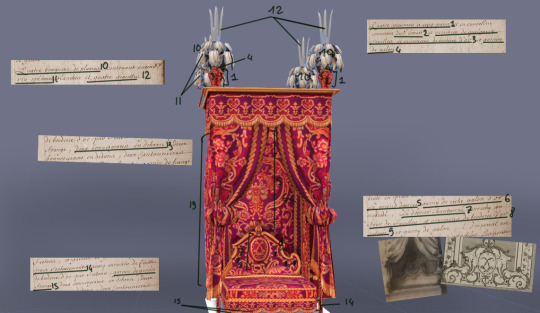
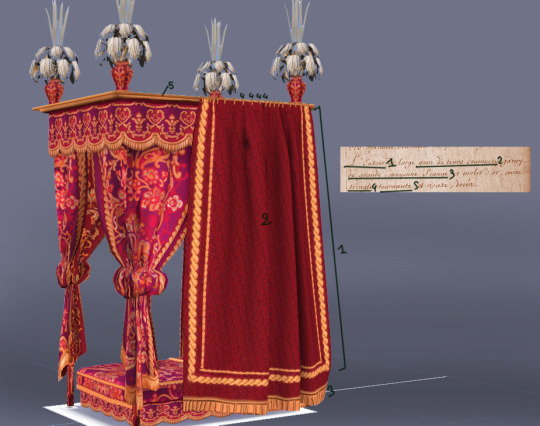
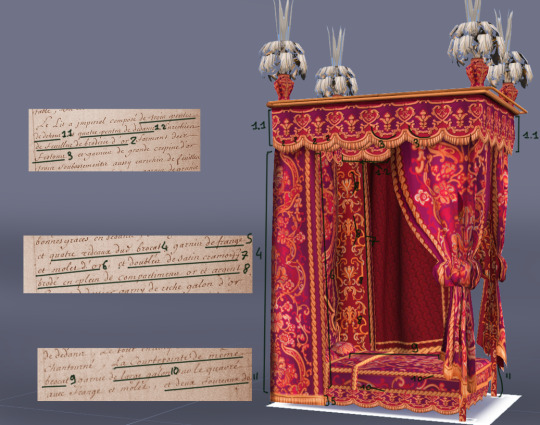
#sims4cc#sims4rococo#ts4cc#the sims 4#ts4ccfurniture#sims 4#sims custom content#ts4 custom content#sims4 palace#sims4palace#Louis XV#Versailles#louis xiv
192 notes
·
View notes
Text
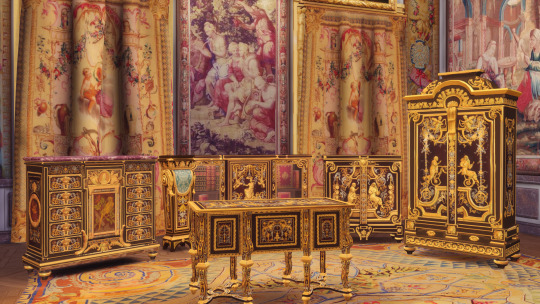
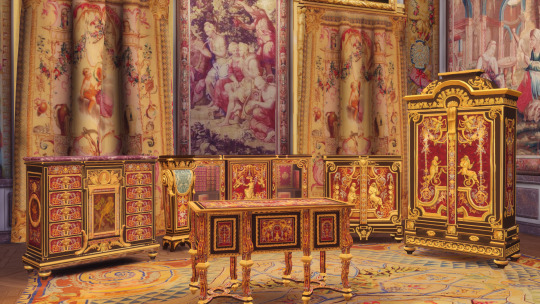
For the amateurs of Boulle marquetries 😉
#sims4cc#ts4cc#the sims 4#ts4ccfurniture#sims custom content#sims 4#ts4 custom content#sims4rococo#ts4 historical#versailles
101 notes
·
View notes
Text

Fixed armchair colour. I realized that the armchairs had some abnormally dark colour on the gilded parts of the armrests you can download the fixed version here
#sims4cc#sims4rococo#sims 4 custom content#ts4cc#ts4 historical#the sims 4#ts4ccfurniture#sims custom content#ts4 custom content#sims 4
99 notes
·
View notes
